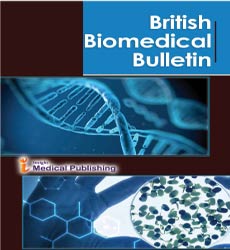ISSN : 2347-5447
British Biomedical Bulletin
Pharmacological Perturbation of Biomolecules Capturing Dynamic Information and Visualization of Physiological Processes in Live Cells and Tissues
Derk ten Berge*
Department of Cell Biology, University Medical Center Rotterdam, Rotterdam, The Netherlands
- *Corresponding Author:
- Derk ten Berge
Department of Cell Biology, University Medical Center Rotterdam, Rotterdam, The Netherlands
E-mail:Derkberge10@gamil.com
Received date: : July 05, 2022, Manuscript No. IPBBB-22-14498; Editor assigned date: : July 07, 2022, PreQC No. IPBBB-22-14498(PQ); Reviewed date:July 23, 2022, QC No IPBBB-22-14498; Revised date:: : July 31, 2022, Manuscript No. IPBBB-22-14498 (R); Published date:Aug 08, 2022, DOI: 10.36648/2347-5447.10.4.4
Citation: Berge TD (2022) Pharmacological Perturbation of Biomolecules Capturing Dynamic Information and Visualization of Physiological Processes in Live Cells and Tissues. Br Biomed Bull Vol. 10 Iss No.4:004.
Description
It has been 2 years since the beginning of the coronavirus pandemic in December of 2019. The spread of the virus has had an unforeseen impact on human lives worldwide. Over the past year, the development of COVID-19 vaccines at record speed is an unprecedented scientific achievement. While the vaccine has proven to be effective in reducing the severity of the disease, the virus continues to be a threat as new variants emerge. Thousands of researchers across the world, both in academia and industry, are striving to develop innovative ways to fight against SARS-CoV-2. As we head into 2022 with the increasing spread of omicron variant, at Cell Chemical Biology we are thinking about the contributions of chemical biology to understanding the mechanism of COVID-19 and many other diseases. In this issue, we have assembled a collection of articles leveraging innovative chemical biology strategies to gain insight into a wide variety of biological problems, including SARS-COV-2 inhibition and more. All 14 articles contained within this issue are original submissions and focus on novel imaging approaches and labeling strategies including chemical modifications, development of biosensors, and small molecule probes. These new technologies have enabled the pharmacological perturbation of biomolecules capturing dynamic information and visualization of physiological processes in live cells and tissues.
Knowledge of Interactions between SARS-CoV-2 and Humans
The first two articles in this collection report methodologies that are being employed in developing new drugs for COVID-19 treatment. Targeting of the SARS-CoV-2 spike protein and its interaction with the human angiotensin-converting enzyme 2 (ACE2) receptor has been identified as a strategy to prevent viral entry. Recent key studies have unraveled that the Receptor Binding Domain (RBD) of the spike protein interacts with ACE2. To extend the knowledge of interactions between SARS-CoV-2 and humans, investigated the interactome of 29 viral proteins in human cells using a biotin-ligase-based proximity labeling technology. The authors identified multiple human proximal proteins as interactors of SARS-CoV-2 and report that the virus manipulates key cellular processes in antiviral and immune responses. The proximity labeling map of SARS-CoV-2 provides a resource for further investigation of the mechanisms of viral infection. Focusing on monitoring RBD-ACE2 interaction in a physiological context developed an innovative, quantitative, time-resolved FRET assay capable of detecting SARS-CoV-2 spike interactions with ACE2 in living cells. The assay can be used for drug screening to identify novel inhibitors of the ACE-RBD complex and for characterizing therapeutic neutralizing antibodies or vaccine efficacy. At the cell surface of several types of immune system cells, the interleukin 23 receptor (IL-23R) interacts with the pro-inflammatory cytokine IL-23. To understand the mechanism of receptor-ligand interaction, employed nanoluciferase bioluminescence resonance energy transfer and measured the interaction of fluorescent-labeled IL-23 with nanoluciferase-fused receptors in living cells.
Identification of New Targets in the Field of Glycobiology
The study provides a toolkit to characterize IL-23R antagonists and demonstrates that the receptor interface could be a potential target to disrupt IL-23 receptor heteromer formation and signaling. The next two articles focus on protein glycosylation. Identification of new targets in the field of glycobiology and targeting of cancer-associated glycans with chemical biology and drug discovery technologies have potential in cancer therapy. Glycans are typically attached to cell-surface membrane proteins, for example, receptors and channels and characterization of glycan-mediated interactions remains challenging due to low binding affinities. With recent advances in multi-omics approaches and glycan imaging, the groups of subjected glioma biopsies to on-tissue matrix-assisted laser desorption ionization N-glycan mass spectrometry imaging and glycoproteomics. They identified multiple spatially localized glycoproteins with N-linked glycoconjugates and different glycopeptide changes between tumor and benign regions. Focusing on characterization of glycan-protein interactions developed a metabolic labeling strategy to incorporate photocrosslinkers into cellular N-glycans; this enabled covalent crosslinking between N-linked glycoproteins and extracellular glycan-binding proteins, allowing investigation of glycan-protein binding events in their cellular context.
Open Access Journals
- Aquaculture & Veterinary Science
- Chemistry & Chemical Sciences
- Clinical Sciences
- Engineering
- General Science
- Genetics & Molecular Biology
- Health Care & Nursing
- Immunology & Microbiology
- Materials Science
- Mathematics & Physics
- Medical Sciences
- Neurology & Psychiatry
- Oncology & Cancer Science
- Pharmaceutical Sciences
